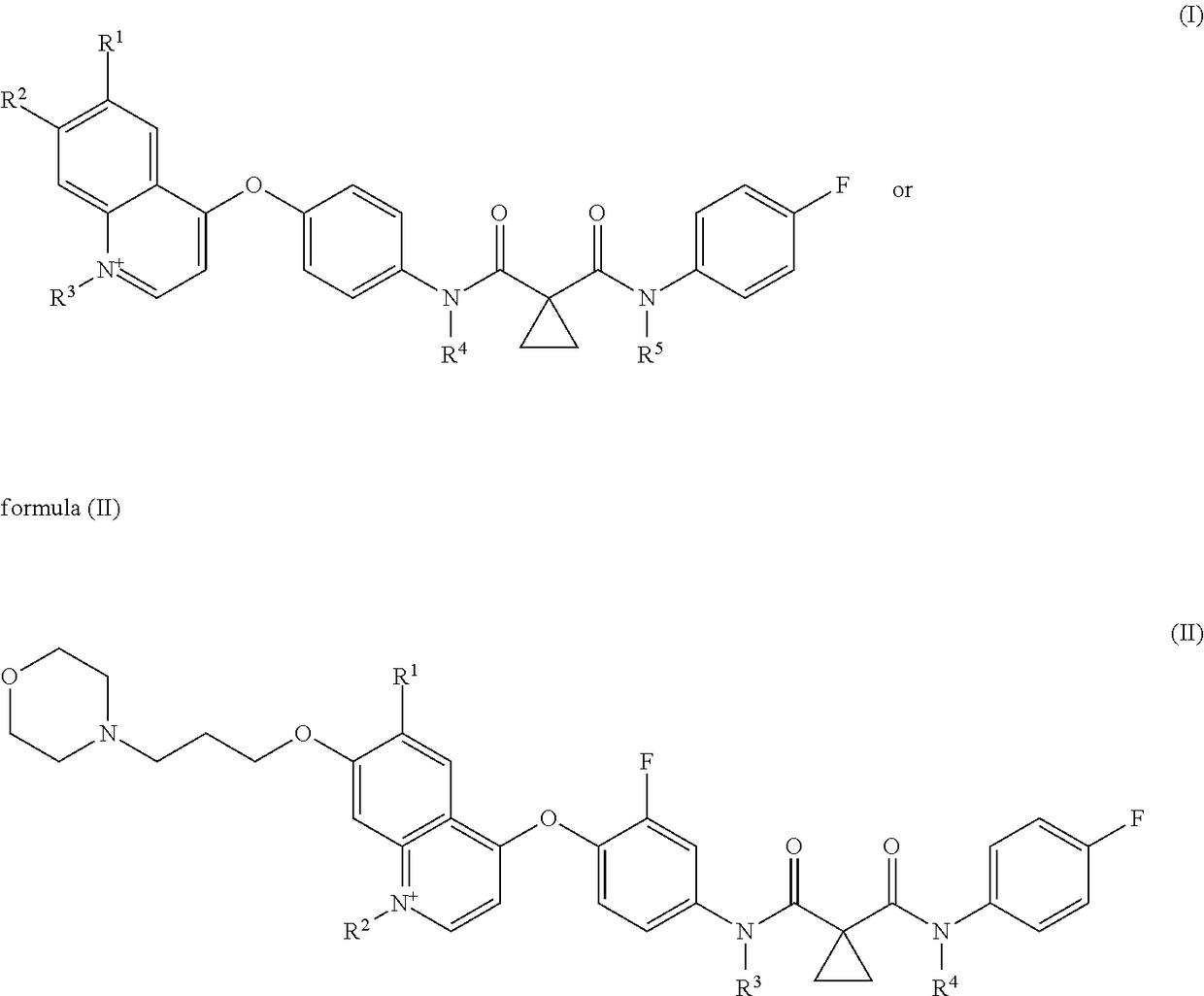Multi-Tyrosine Kinase Inhibitors Derivatives and Methods of Use
a technology of tyrosine kinase and derivatives, applied in the direction of organic chemistry, pharmaceutical delivery mechanism, heterocyclic compound active ingredients, etc., can solve the problems of vision loss, capillary drop out, microaneurysms, ischemia, leakage of retina, etc., to suppress or prevent wet macular degeneration
- Summary
- Abstract
- Description
- Claims
- Application Information
AI Technical Summary
Benefits of technology
Problems solved by technology
Method used
Image
Examples
example 1
Synthesis of Cabozantinib N-acyl methyl Palmitate
[0106]
Method
[0107]Cabozantinib was incubated with bromomethyl palmitate in the presence of tetraphenylborate (“NaBPh4”), acetonitrile (“CH3CN”) at 82° C. for X hours resulting in cabozantinib N-acyl methyl palmitate tetraphenylborate. The cabozantinib N-acyl methyl palmitate tetraphenylborate is then incubated with Dowex®-1-chloride (Dowex is a registered trademark of Dow Chemical Company) and acetonitrile:isopropyl alcohol (iPA) to yield cabozantinib N-acyl methyl palmitate chloride.
example 2 (
Virtual)
Formulation
[0108]Cabozantinib N-acyl methyl palmitate (CNAMP) was formulated for intravitreal injection using isopropyl myristate or oleic acid combined with about 10% w / v cyclodextrin and from about 10% to about 30% w / v D-alpha tocopherol PEG 1000 succinate (“TGPS”) which were then solubilized via well-known oil solubilization techniques to create a first solution. The first solution was then added to a saturated fatty acid (e.g. octanoic acid) combined with lecithin or lecithin derivatives (e.g. phosphatidyl choline), a glycerol fatty acid ester (e.g. propylene glycol fatty acid esters such as polyoxyethyleneglycerol triricinoleate), a sorbitan fatty acid ester (e.g. Span® 20, Span® 80) or a olyoxylethylene sorbitan fatty acid ester (e.g. Tween® 20, Tween® 80), and optionally a co-surfactant (e.g. propylene glycol, glycerol, PEG 400, 1,2-propanediol), which were then solubilized as a microemulsion using commercial lipoemulsion techniques (e.g. Intralipid®, Abbolipid).
Metho...
example 3
Method
[0112]Compounds 1-4 and cabozantinib were each tested for binding of c-Met, VEGFR2, TIE2 and the control compound, staurosporine. Specifically, each compound was tested at a 3-fold serial dilution starting at 10 microMolar (“μM”) in a 10-dose IC50 mode into an enzyme / substrate mixture using acoustic technology, and pre-incubated for 20 minutes to ensure compounds were equilibrated and bound to the enzyme. Staurosporine was used as a control and was tested at a 4-fold serial dilution starting at 20 μM. Next, 5 concentrations of ATP were added to initiate the reaction. The activity was monitored every 5-15 min for a time course study.
TABLE 3IC50 Data for Compounds 1-4 on Various KinasesCompound IC50* (M):[ATP]Stauro-Cabo-Com-Kinase(μM):sporinezantinibpound 1Compound 2c-Met102.16E−074.41E−083.76E−06VEGFR2201.86E−083.79E−08TIE2301.20E−07 4.90E−071.03E−06*Empty cells indicate no inhibition or compound activity that could not be fit to an IC50 curve for any of...
PUM
| Property | Measurement | Unit |
|---|---|---|
| Time | aaaaa | aaaaa |
| Time | aaaaa | aaaaa |
| Time | aaaaa | aaaaa |
Abstract
Description
Claims
Application Information
 Login to View More
Login to View More - R&D
- Intellectual Property
- Life Sciences
- Materials
- Tech Scout
- Unparalleled Data Quality
- Higher Quality Content
- 60% Fewer Hallucinations
Browse by: Latest US Patents, China's latest patents, Technical Efficacy Thesaurus, Application Domain, Technology Topic, Popular Technical Reports.
© 2025 PatSnap. All rights reserved.Legal|Privacy policy|Modern Slavery Act Transparency Statement|Sitemap|About US| Contact US: help@patsnap.com



